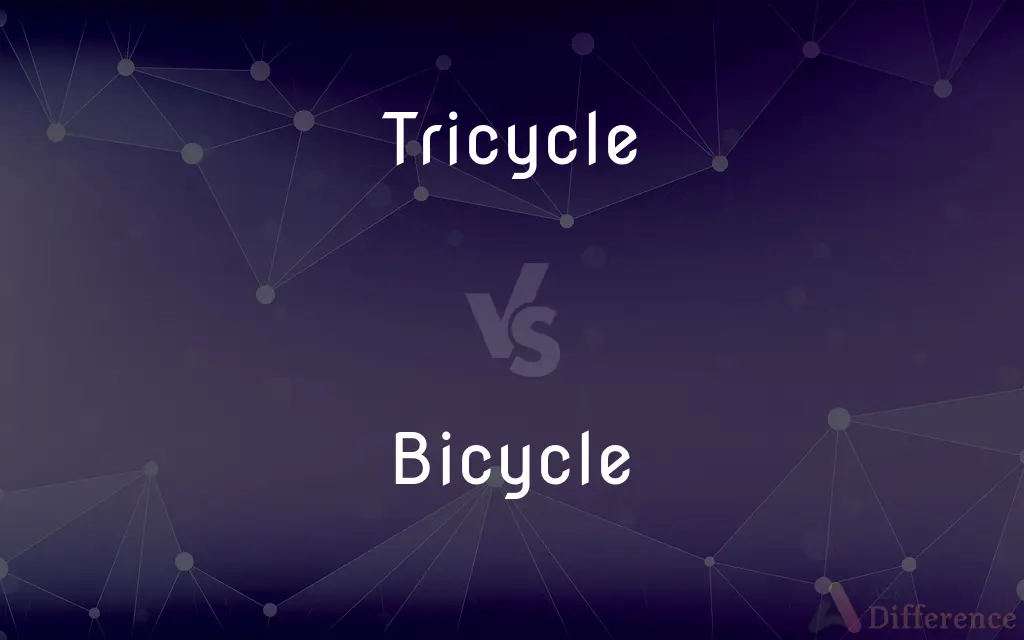Tricycle vs. Bicycle — What's the Difference?
By Fiza Rafique & Urooj Arif — Updated on April 24, 2024
A tricycle features three wheels for stability and is often used by children and elders needing extra support, whereas a bicycle has two wheels, requiring balance and is widely used for recreation and commuting.

Difference Between Tricycle and Bicycle
Table of Contents
ADVERTISEMENT
Key Differences
A tricycle, equipped with three wheels, offers enhanced stability, making it an ideal choice for young children learning to ride or for elders who require additional balance support. This stability allows for a safer, low-speed ride without the need for balancing skills. On the other hand, a bicycle consists of two wheels and requires the rider to maintain balance, catering to a broader range of activities, including sport, recreation, and transportation.
Tricycles often have a robust structure that supports more weight and provides a sturdy platform for riders. They are particularly popular among toddlers and senior people who might find balancing challenging. Whereas bicycles, with their lighter and more streamlined design, are favored for their speed and agility, appealing especially to those looking to cover longer distances more efficiently.
The riding dynamics of a tricycle mean that they typically move slower and are less maneuverable than bicycles. This makes tricycles a common choice in controlled environments or for leisurely rides within community spaces. Bicycles, however, are designed for both urban environments and rugged terrain, offering greater versatility with the ability to navigate through various settings quickly.
Safety features on tricycles often include a low center of gravity, which reduces the risk of tipping over. Many tricycles also come equipped with cargo baskets for carrying goods, enhancing their utility. In contrast, bicycles are built for efficiency and speed, with optional gear systems that allow for varying riding styles and speeds across different terrains.
While both tricycles and bicycles provide unique cycling experiences, the choice between the two typically depends on the rider's age, balance capabilities, and the intended use of the cycle, whether for stable, leisurely rides or for more dynamic, versatile cycling.
ADVERTISEMENT
Comparison Chart
Number of Wheels
Three, offering more stability.
Two, requiring balance and coordination.
Typical Users
Toddlers, seniors, or those with balance issues.
Users of all ages with good balance skills.
Speed and Agility
Generally slower and less agile.
Faster and highly agile.
Usage
Safe, stable rides; often used for leisure.
Versatile, used for sport, commuting, etc.
Safety
Lower risk of tipping due to stability.
Higher risk of falls; requires skill.
Compare with Definitions
Tricycle
Often used by children or for carrying loads due to its stability.
He uses a heavy-duty tricycle for his daily deliveries.
Bicycle
A vehicle consisting of two wheels held in a frame one behind the other, propelled by pedals.
He commutes to work daily on his bicycle.
Tricycle
Typically slower and suited for safe, leisurely rides.
The seniors at the park rode tricycles for their morning exercise.
Bicycle
Used for various purposes including sport, recreation, and transportation.
She participated in the bicycle race last weekend.
Tricycle
A vehicle similar to a bicycle, but with three wheels, two at the back and one at the front.
The toddler enjoyed her ride on the colorful tricycle.
Bicycle
Popular worldwide for its efficiency and health benefits.
Cycling on a bicycle is an excellent form of cardiovascular exercise.
Tricycle
Provides support for those with limited balance.
The adult tricycle was perfect for her as she had difficulty balancing.
Bicycle
Requires balancing ability by the rider.
Learning to ride a bicycle is a milestone in many children's lives.
Tricycle
Can have additional features like a basket for utility.
Her tricycle came with a large basket for grocery shopping.
Bicycle
Can be equipped with gears for different terrains and speeds.
His mountain bicycle has multiple gears for rough terrain.
Tricycle
A tricycle, often abbreviated to trike, is a human-powered (or gasoline or electric motor powered or assisted, or gravity powered) three-wheeled vehicle. Some tricycles, such as cycle rickshaws (for passenger transport) and freight trikes, are used for commercial purposes, especially in the developing world, particularly Africa and Asia.
Bicycle
A bicycle, also called a bike or cycle, is a human-powered or motor-powered, pedal-driven, single-track vehicle, having two wheels attached to a frame, one behind the other. A bicycle rider is called a cyclist, or bicyclist.
Tricycle
A vehicle, used especially by small children, that has three wheels, one at the front and two at the back, and is usually propelled by pedals.
Bicycle
A vehicle consisting of a light frame mounted on two typically wire-spoked wheels one behind the other and usually having a seat, handlebars for steering, brakes, and two pedals by which it is driven.
Tricycle
A cycle with three wheels, powered by pedals and usually intended for young children.
Bicycle
An exercise bicycle.
Tricycle
(Philippines) An autorickshaw; A motorized cycle rickshaw
Bicycle
To ride or travel on a bicycle.
Tricycle
To ride a tricycle.
The child tricycled around the driveway until dark.
Bicycle
A vehicle that has two wheels, one behind the other, a steering handle, and a saddle seat or seats and is usually propelled by the action of a rider’s feet upon pedals.
Tricycle
A three-wheeled velocipede. See Illust. under Velocipede. Cf. Bicycle.
Bicycle
A traveling block used on a cable in skidding logs.
Tricycle
A vehicle with three wheels that is moved by foot pedals
Bicycle
The best possible hand in lowball.
Bicycle
A motorbike.
Bicycle
A slut; a promiscuous woman.
Bicycle
(climbing) A stabilizing technique in which one foot is pushed down while the other is pulled up.
Bicycle
(ambitransitive) To travel or exercise using a bicycle.
Bicycle
To physically ship (a recorded programme) to another broadcasting entity.
Bicycle
A light vehicle having two wheels one behind the other. It has a saddle seat and is propelled by the rider's feet acting on cranks or levers.
Bicycle
A wheeled vehicle that has two wheels and is moved by foot pedals
Bicycle
Ride a bicycle
Common Curiosities
Are tricycles safer than bicycles?
Yes, in terms of stability and reduced risk of falling, tricycles are generally safer.
Who typically uses tricycles?
Tricycles are often used by toddlers learning to ride, seniors, or those needing extra stability.
Can bicycles carry as much weight as tricycles?
Typically, no; tricycles are more suited for carrying heavier loads due to their stability.
Are tricycles popular in urban areas?
They are less common than bicycles in busy urban areas due to their size and slower speed.
What type of bicycle is best for rough terrain?
Mountain bicycles, equipped with special gears and robust frames, are best for rough terrain.
What are the main differences between a tricycle and a bicycle?
The main difference is the number of wheels; tricycles have three for stability, bicycles have two requiring balance.
Can adults use tricycles?
Yes, many adults who require stability or have balance issues choose tricycles.
Why do people use bicycles for commuting?
Bicycles are efficient, environmentally friendly, and can navigate through traffic more easily than cars.
Can tricycles be used for sport?
While less common, there are sport models of tricycles designed for racing and fitness.
What are the health benefits of riding a bicycle?
Riding a bicycle improves cardiovascular health, builds muscle tone, and can aid in weight management.
Share Your Discovery

Previous Comparison
Evil vs. Agathokakological
Next Comparison
Army vs. SoldierAuthor Spotlight
Written by
Fiza RafiqueFiza Rafique is a skilled content writer at AskDifference.com, where she meticulously refines and enhances written pieces. Drawing from her vast editorial expertise, Fiza ensures clarity, accuracy, and precision in every article. Passionate about language, she continually seeks to elevate the quality of content for readers worldwide.
Co-written by
Urooj ArifUrooj is a skilled content writer at Ask Difference, known for her exceptional ability to simplify complex topics into engaging and informative content. With a passion for research and a flair for clear, concise writing, she consistently delivers articles that resonate with our diverse audience.
















































